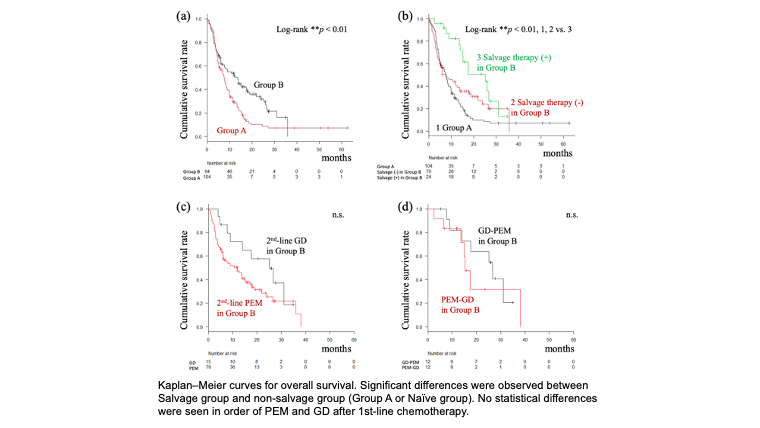Back
Poster, Podium & Video Sessions
MP03: Bladder Cancer: Invasive I
MP03-18: Chronological transition in outcome of second-line treatment in patients with metastatic urothelial cancer after pembrolizumab usage: A multicenter analysis
Friday, May 13, 2022
7:00 AM – 8:15 AM
Location: Room 222
TERUKI ISOBE*, TAKU NAIKI, YOSUKE SUGIYAMA, AYA NAIKI, TAKASHI NAGAI, TOSHIKI ETANI, SATOSHI NOZAKI, KEITARO IIDA, YUSUKE NODA, NOBUHIKO SHIMIZU, NAMI TOMIYAMA, Nagoya City, Japan, RIKA BANNO, Konan City, Japan, HIROKI KUBOTA, Yatomi City, Japan, SHUZO HAMAMOTO, RYOSUKE ANDO, NORIYASU KAWAI, TAKAHIRO YASUI, Nagoya City, Japan
- TI
Poster Presenter(s)
Introduction: After first-line chemotherapy failure, patients with metastatic urothelial carcinoma (mUC) undergo pembrolizumab (PEM) or gemcitabine and docetaxel (GD) therapy. We retrospectively investigated outcomes of second-line GD or PEM for mUC patients.
Methods: A total of 198 mUC patients from Nagoya City University and affiliated hospitals who received second-line treatment were grouped according to immune check point inhibitor (ICI) availability: Group A (pre-ICI: n=104) and Group B (post-ICI: n=94). We compared clinical outcomes using Kaplan–Meier curves. Univariate and multivariate Cox regression analyses assessed potential prognostic factors for overall survival (OS).
Results: Median OS was significantly longer Group B (median 13.6 months, 95% confidence interval [CI]: 7.6–17.6) than Group A (7.6 months, 5.3–8.8). By sub-group analysis, patients received no additional treatment (Naïve group, n=70), or PEM or GD (Salvage group, n=24) in Group B, and median OS of Naïve and Group A were similar. Significant differences in OS were observed compared with the Salvage group (median 7.6 months, 95% CI: 5.3–8.8; Group A, 7.6 months, 4.7–13.8; Naïve group, 25.7 months, 14.0–31.0; p < 0.01). For the Salvage group, OS of sequential treatment of GD–salvage PEM and PEM–salvage GD patients were similar (p=0.10). Multivariate analysis showed a low neutrophil-to-lymphocyte ratio (NLR) and high geriatric nutritional risk index (GNRI) as significant prognostic factors affecting long OS (95% CI: 1.12–3.45, hazard ratio (HR): 1.97; and 95% CI: 0.24–0.71, HR: 0.41, respectively).
Conclusions: With reference to real-world data, second-line GD or PEM therapy for mUC patients showed equivalent survival benefits. Either PEM or GD treatments can be predicted to extend the prognosis by increasing the patients applicable for salvage therapy after second-line treatment. In addition, GNRI and NLR are worthy prognostic biomarkers when considering survival outcomes in practical treatment.
Source of Funding: No source of funding.

Methods: A total of 198 mUC patients from Nagoya City University and affiliated hospitals who received second-line treatment were grouped according to immune check point inhibitor (ICI) availability: Group A (pre-ICI: n=104) and Group B (post-ICI: n=94). We compared clinical outcomes using Kaplan–Meier curves. Univariate and multivariate Cox regression analyses assessed potential prognostic factors for overall survival (OS).
Results: Median OS was significantly longer Group B (median 13.6 months, 95% confidence interval [CI]: 7.6–17.6) than Group A (7.6 months, 5.3–8.8). By sub-group analysis, patients received no additional treatment (Naïve group, n=70), or PEM or GD (Salvage group, n=24) in Group B, and median OS of Naïve and Group A were similar. Significant differences in OS were observed compared with the Salvage group (median 7.6 months, 95% CI: 5.3–8.8; Group A, 7.6 months, 4.7–13.8; Naïve group, 25.7 months, 14.0–31.0; p < 0.01). For the Salvage group, OS of sequential treatment of GD–salvage PEM and PEM–salvage GD patients were similar (p=0.10). Multivariate analysis showed a low neutrophil-to-lymphocyte ratio (NLR) and high geriatric nutritional risk index (GNRI) as significant prognostic factors affecting long OS (95% CI: 1.12–3.45, hazard ratio (HR): 1.97; and 95% CI: 0.24–0.71, HR: 0.41, respectively).
Conclusions: With reference to real-world data, second-line GD or PEM therapy for mUC patients showed equivalent survival benefits. Either PEM or GD treatments can be predicted to extend the prognosis by increasing the patients applicable for salvage therapy after second-line treatment. In addition, GNRI and NLR are worthy prognostic biomarkers when considering survival outcomes in practical treatment.
Source of Funding: No source of funding.


.jpg)
.jpg)